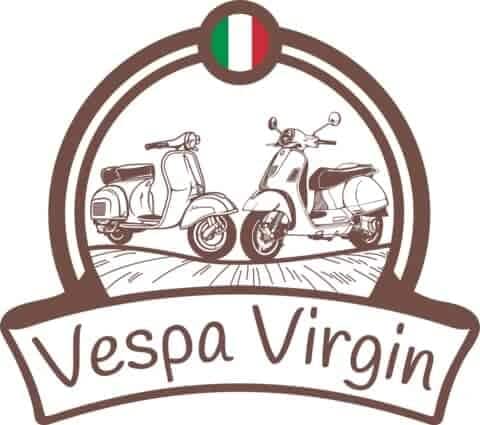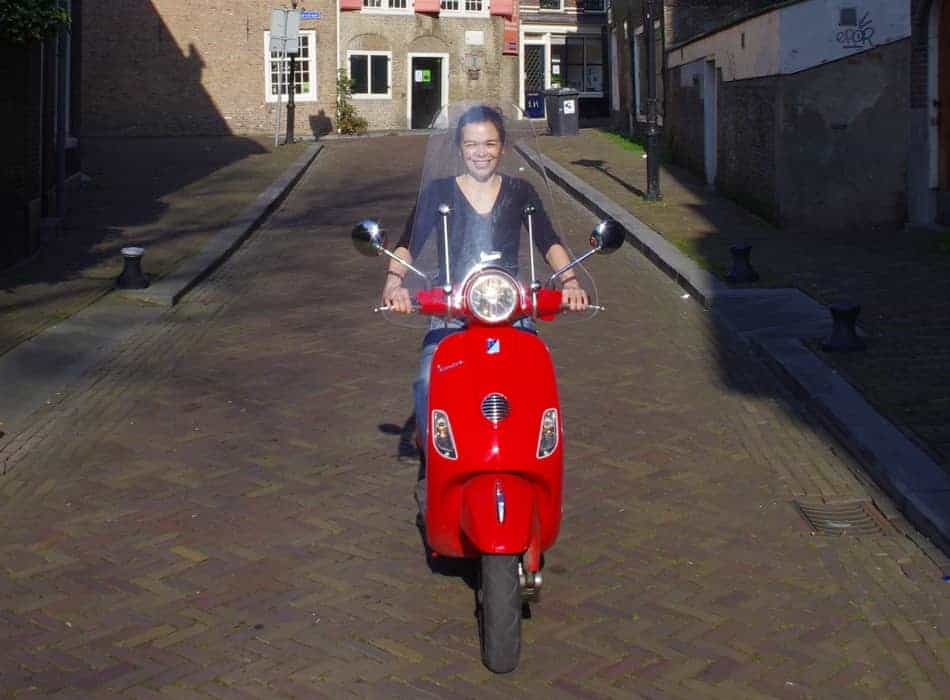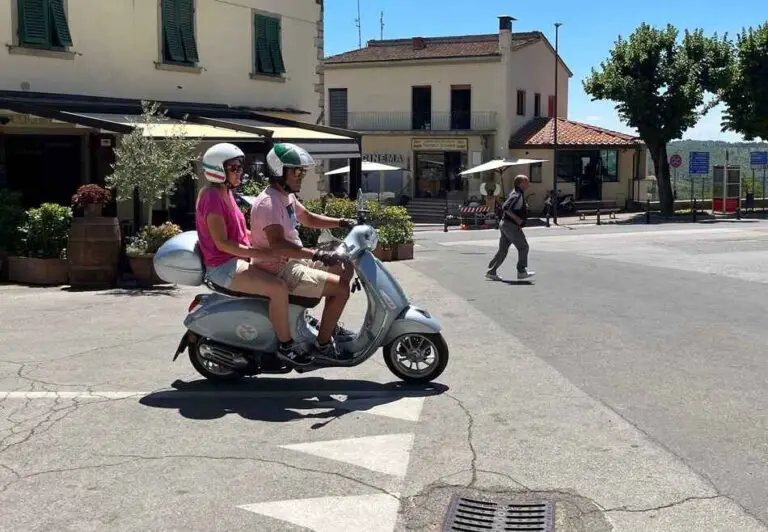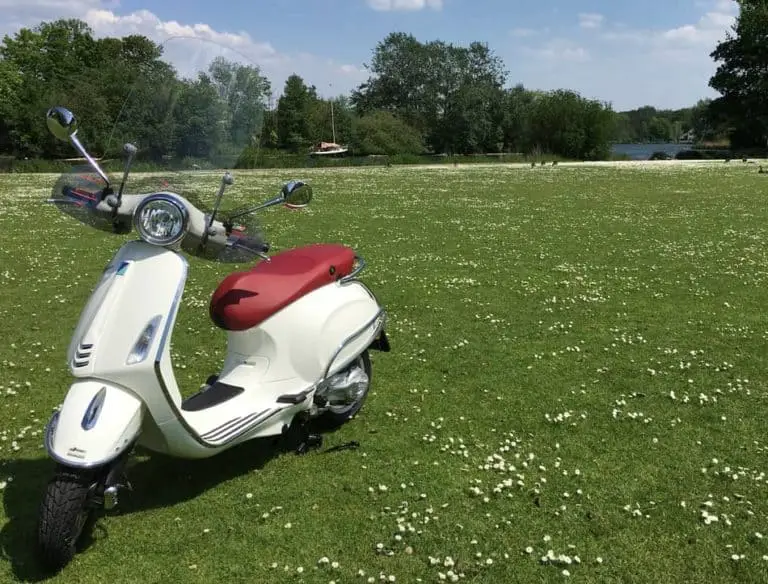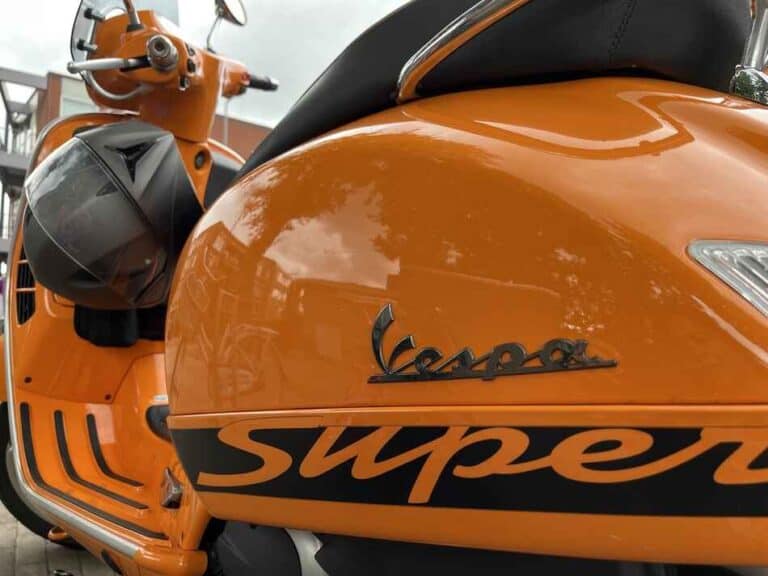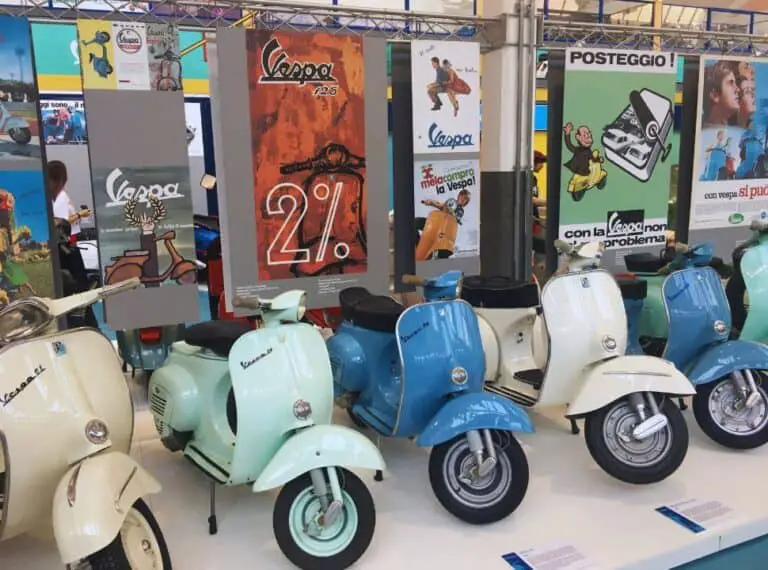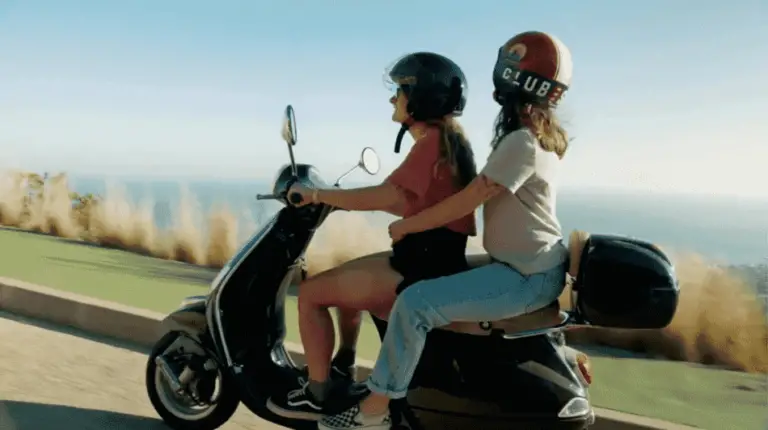How To Ride A Vespa For The First Time? (Automatic And Gears)
Not only is a Vespa a practical way to get around, especially in cities but it is fun to ride too. More people have discovered the advantages of driving one, and more Vespas are now buzzing around.
But what if you have never driven a Vespa before? Then these step-by-step instructions will have you on your way in no time. We will start off with tips on riding an automatic Vespa. In the end, we will explain how to ride a classic manual Vespa.
As a rental company, we had a lot of people who had never ridden a Vespa, scooter, or moped at all. We had many scary situations where someone would drive off uncontrollably. We even had one shooting off, luckily driving exactly between two parking cars and stopping right on the pavement with its front wheel just barely touching a brick wall.
If you are riding a Vespa for the first time, you have to take it seriously. A bit of confidence is good, but being overconfident and assuming you have everything under control can lead to accidents.
1. Check the switches and the brakes
While you might be eager to hop on and drive off, the number 1 step is probably the most important. It is important to know where everything is before you are driving only to realize that you don’t know where the rear brake is located.
2. Sit properly for better manoeuvrability
A proper posture makes the Vespa more manoeuvrable. Take a seat and place both hands on the handlebars. Find the correct balance by shifting your body and the Vespa to the left and right. This way you will also get more feeling of the Vespa.
Make sure you are sitting upright and bend your elbows slightly. Don’t stretch your arms when riding a Vespa as this will make turning and maneuvering more difficult.
Once you are sitting comfortably check if your footing is fine as well. Can you touch the ground easily? With both feet or just one? You need to know what is best for you as you will need to place your footing firmly on the ground every time you stop.
A Vespa is quite heavy. Always make sure you are able to find proper balance and footing when stopping
3. Test the front and rear brakes so you know how to stop
Play a bit with the brakes. When seated, push the Vespa forward and experiment with the brakes. Try to break gradually but also test how it feels when you brake suddenly. Use the front and rear brakes separately and then simultaneously, starting with the front brake followed by the rear.
The rear brake is good for slow driving and manoeuvring at low speeds, for instance during heavy traffic. When using the rear brake you can still stir slightly.
The front brake has the most stopping power and should be used for high-speed braking. The front brake is important because the weight of the Vespa and the driver is shifted forward. So the front wheel suspension and the brakes need to stop the sudden weight.
There are three points you should be aware of when using the front brake:
- you can not stir
- always have the handlebars in the straight position
- always sit upright
Never squeeze the brake too hard and too fast, this can lock up the rear wheel. Braking should be done progressively
4. Adjust the mirrors to be able to see all angles
Check if you are able to use the mirrors properly. Not only is handling the Vespa important, but being aware of your surroundings when driving is just as crucial. Adjust the mirrors accordingly so you have a good view of the back, both left and right.
5. Play with the throttle to get accustomed
Place your hand on the throttle. Make sure you put your wrist straight when you hold the throttle. This is the neutral position. Twist the throttle towards you so you can get accustomed to twisting it.
Don’t forget to make the “vroom vroom” sound to make it more realistic. 😉
6. Switch on the Vespa to start the engine
Now it is time to turn the key in the ignition and start the Vespa. The most important thing to remember is not to twist the throttle while doing this. If you are new and you would immediately turn the throttle when starting the Vespa you are likely to fly off. So keep your right hand relaxed.
Once you have turned the key, the display will lighten up. Then squeeze the left brake lever and at the same time press the ignition button with your right thumb. The Vespa should start immediately.
At this point, you are able to let go of the brakes and the handlebars. The Vespa should be idling. This will be the position when you will be waiting at a traffic light for example.
Relax your hands on the handlebars when starting the Vespa. Never turn the throttle when pushing the ignition button.
7. Drive slowly and practice stopping at any moment
Once you have done all the steps, it is finally to ride a Vespa for your very first time. Place your right hand on the throttle and very slowly pull it towards you. First, check what happens if you twist it a tiny bit. The engine will make more noise and you will notice that the Vespa wants to go. Turn a tiny bit again. The Vespa should be moving slowly by now.
Remember when you made the “vroom vroom” sound? You probably automatically moved your hand back and forth to accelerate. In reality, it doesn’t work like this!
When you accelerate on an automatic Vespa you pull the throttle towards you and stop once you have reached the desired speed. Keep it in this position for a steady speed.
If you want to slow down, turn the throttle hand forward.
How to get more speed?
To gain more speed, turn the throttle slightly more towards you. Turn it even more, till it is halfway. You should be going 10km per hour now and moving comfortably.
Start off moving forward slowly. Too slow will make balancing more difficult. So find a comfortable speed where you are not going too fast but are well balanced. In the beginning, you can always put both feet along the floorboard of the Vespa for proper balance and more security.
If you are still going slow and want to stop, you can just let go of the throttle handle. This will automatically fall back into the neutral position and your Vespa will slowly stop.
Accelerate again and try to make more speed. Now it is time to use the brakes to stop. Role off the throttle handle to stop acceleration and gradually use the brakes to stop the Vespa. Start with the front brake followed by the rear. Make sure you use the proper footing for stabilization once you have stopped fully.
Congratulations, you have successfully had your first Vespa ride.
Never use the brake and the throttle at the same time
8. Practice taking a turn
Once you are comfortable driving a straight line, it is time to make a turn. If you are taking a right turn, push the left hand slowly outwards. This is basically just like a bicycle. Make sure you decelerate when you start the turn. Once out of the turn, slow and gently accelerate again.
At the turn never use the brakes or accelerate. Try to roll on the remaining speed. Make sure you practice both ways: left and right. Some people find turning to the left more difficult than the right.
Never accelerate or use the brakes when making a turn.
9. Use the indicators once you are comfortable driving
While the indicators are important when driving in traffic, it isn’t that crucial when riding a Vespa for the first time. So only once you feel comfortable driving, stopping, and taking turns should you focus on the indicators.
The indicators are located on the left side of the steering wheel and you need to use your thumb to switch it on and off. Unfortunately, in most cases, the indicators do not switch off automatically once you have made the turn. So you need to do this with your thumb again.
Obviously, there will be many times you will forget to switch it off. This happened to us so many times. Just be aware that other drivers might respond to this.
Other tips you should know when riding a Vespa for the first time
Protected clothing – a helmet is in most cases mandatory. However, if it is your first time riding a Vespa you should also cover your arms and legs with sturdy clothing. If you fall it might prevent you from nasty wounds and scratches
Practice in quiet paved streets – you want to focus on getting the hang of the Vespa only. Other distractions should be minimized. Also to avoid hitting a passerby. Paved roads are ideal to avoid sudden bumps and slippery surfaces such as gravel.
Ask for assistance – it is always good to have somebody around to help out during your first Vespa ride. Best if it is somebody who is an experienced Vespa driver. If not, that’s ok too.
When we were helping first-timers we noticed that new drivers found it comfortable if somebody walked along. The person who is assisting can also walk along while holding on to the rear grab rail (just under the seat) of the Vespa for extra stabilization.
Make sure that person doesn’t start pushing the Vespa unconsciously in a certain direction. They should just hold the grab rail loosely while you are driving slowly and you are not confident in balancing and steering yet.
Extra Caution – never ride a Vespa are not fully confident yet. Remember, once you are driving the Vespa on the road you are part of traffic. Driving a Vespa is different than driving a car. Make sure you drive more safely and just assume cars do not see you. If you get hit or get yourself in an accident, you are the one who is hurt. Not the driver of the car.
How to ride a classic Vespa for the first time?
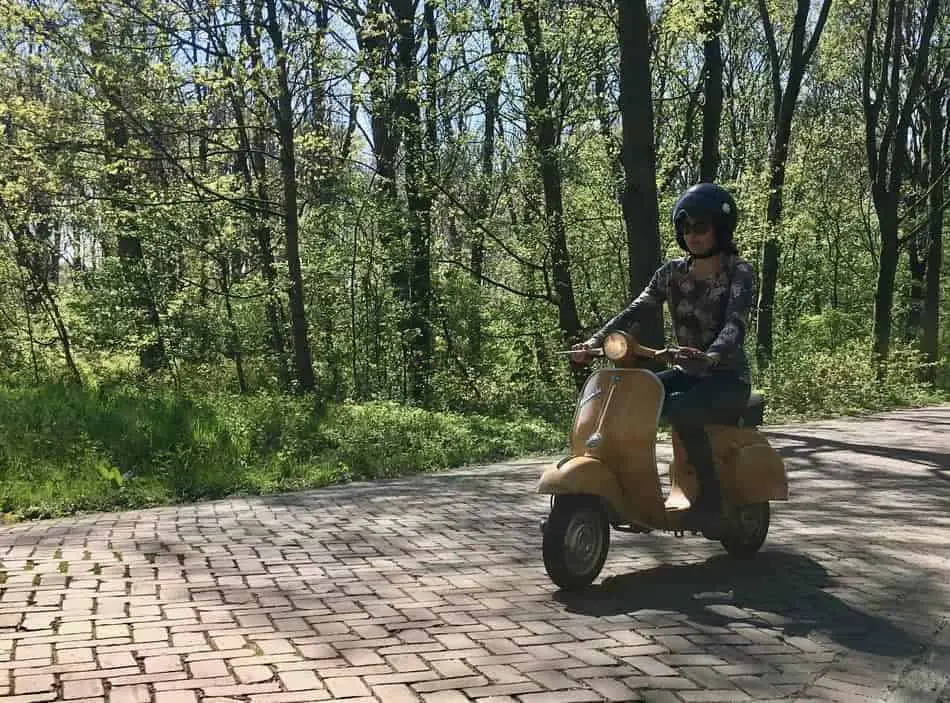
A classic Vespa has gears, making it more challenging than an automatic Vespa. But if you really want to experience riding a classic Vespa then you should definitely have a go.
We recommend first-timers to gain some experience with driving an automatic Vespa first. You will be familiar with steering, taking turns, and handling a Vespa. Once you are, you can then focus on the more ‘complicated’ stuff when driving a classic Vespa.
1. Know where the switches and the brakes are
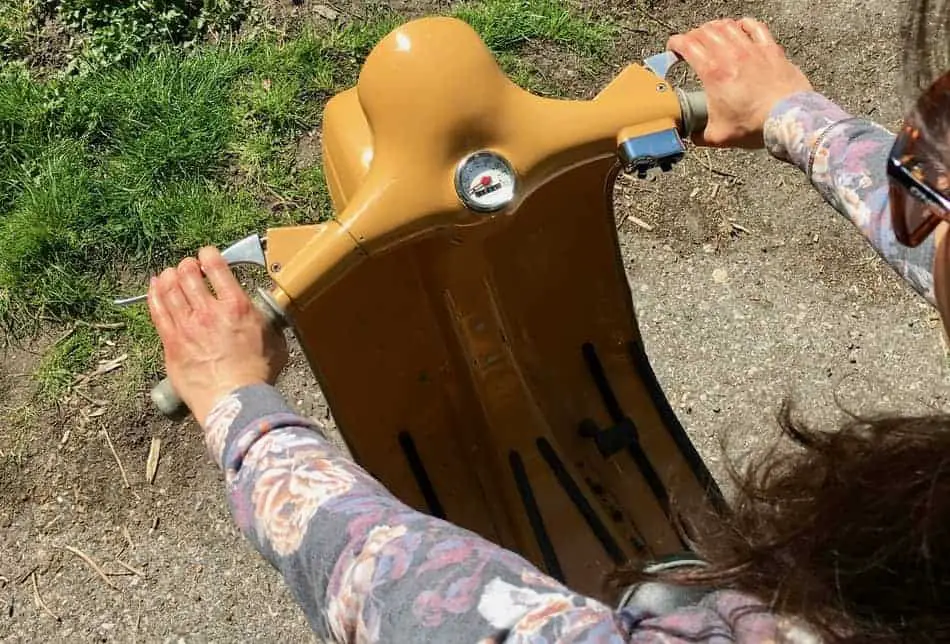
Walk around the Vespa and get to know where everything is. Unlike the automatic, the geared Vespa doesn’t have a rear brake lever. On a classic Vespa, the brake is located near your right foot. It also doesn’t have an ignition button to start the engine and in some cases, it has no indicators.
So make sure you use your hands to indicate to other drivers you are making a turn.
Some do not have mirrors. So when you ride a classic Vespa, look over your shoulder before doing a manoeuvre.
2. Test the brakes to know how to stop
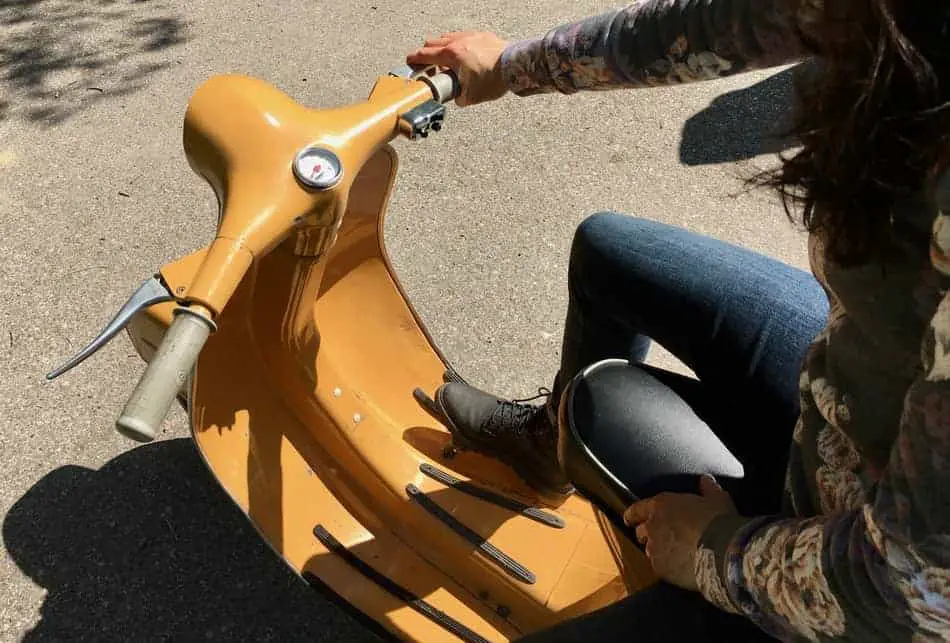
Before you start the engine and want to ride a classic Vespa, you need to, get familiar with the brakes. As mentioned earlier, the rear brake lever is absent. Instead, the left lever is the clutch.
The rear brake is located near your right foot. Press it down with your foot in order to brake. The front brake is located on the right-hand lever.
It may not come as a surprise, but from my own experience, these brakes aren’t the world’s greatest. Especially if you compare it with a modern Vespa. You’ll need more time to fully stop. So please realize this when you ride a classic Vespa in traffic.
The rear brake of a classic Vespa is pretty strong compared to the front brake. So make sure you use this gently as well to make a full stop.
Make sure you anticipate when to use the brake sooner than usual. The brakes on a classic Vespa are not that strong
3. Play with the gears to get the feeling
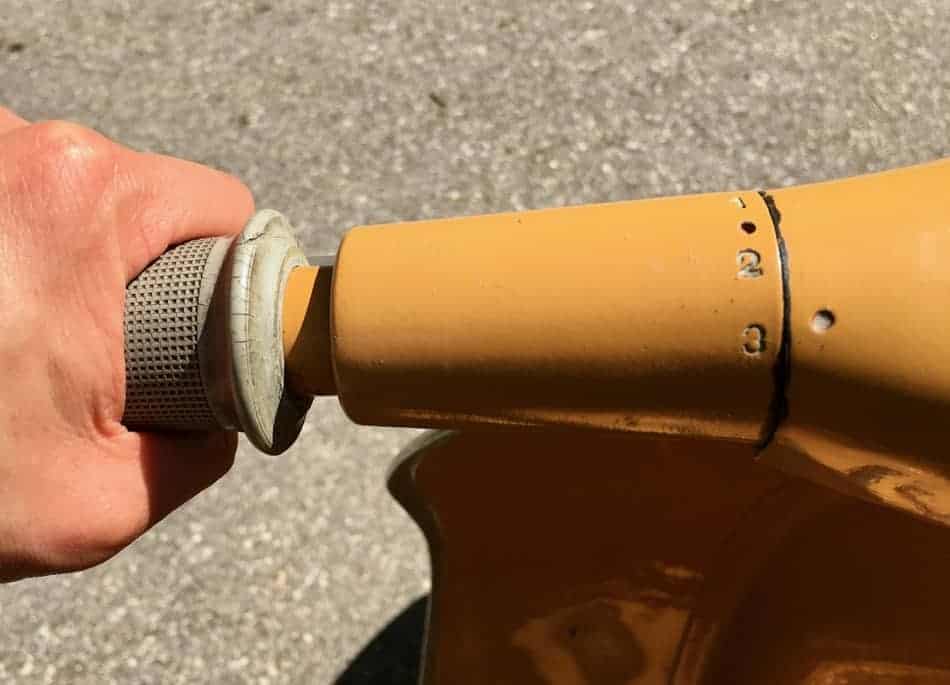
Driving manually is the biggest difference and most important feature of a classic Vespa. The clutch is located in the left handle and in the left lever.
The Vespa has either 3 or 4 gears plus neutral set in the following sequence: 1, neutral (⚫️ ), 2, 3, and 4.
You can change gears by squeezing the gear handle lever and at the same time turn the clutch. It is possible to do this while the engine is off. You do need to sit on the Vespa and use your feet to go back and forth, only then will you be able to change the gears.
Start off by setting it in neutral, then hold the lever and turn the handle forward to the 1st gear. You will hear it fall in place with a low ‘clunk’ sound. From there move straight to 2, 3, and optional 4. Don’t forget to keep moving the Vespa when you do this.
It might feel difficult at first, but it will go much smoother once you are driving.
4. Start the Vespa in neutral and switch to the first gear
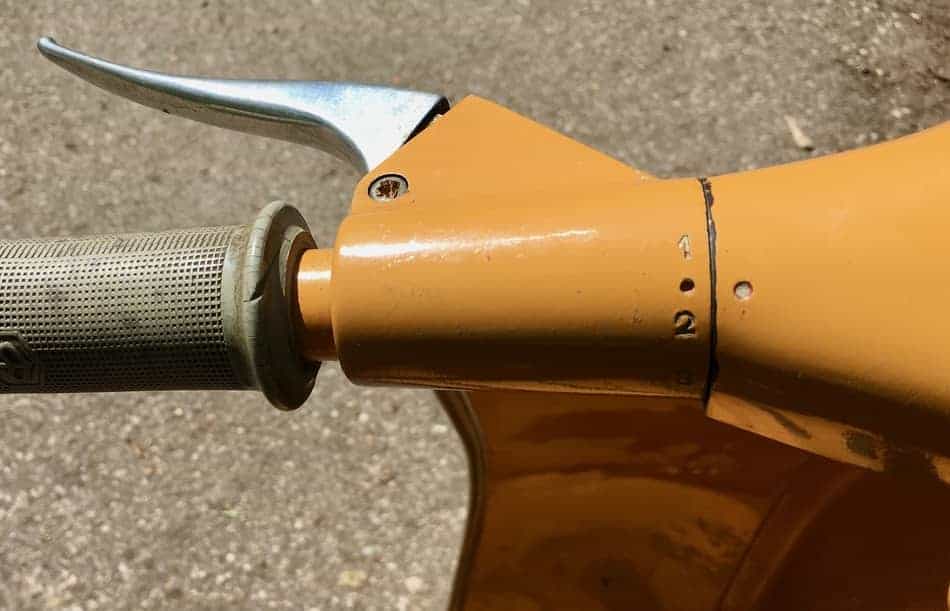
Once you know how the gears work, it is time to start the Vespa. You need to use the kickstart to do so. So it’s time to get off the Vespa again and do the following:
- Place the Vespa on the main stand and make sure it is in the neutral gear
- Hold both or just the right handle and saddle while placing one foot on the kickstand. I prefer my right foot
- Then push the kickstart down with your foot. You might need a couple of goes. If the engine is still cold, pull out the choke (round button between the seat and the floorboard).
You will hear the Vespa ‘waking up’. To help her along, turn the throttle handle so the engine will start running. Once the Vespa is idling, take a seat and push the Vespa forward to take it off the stand.
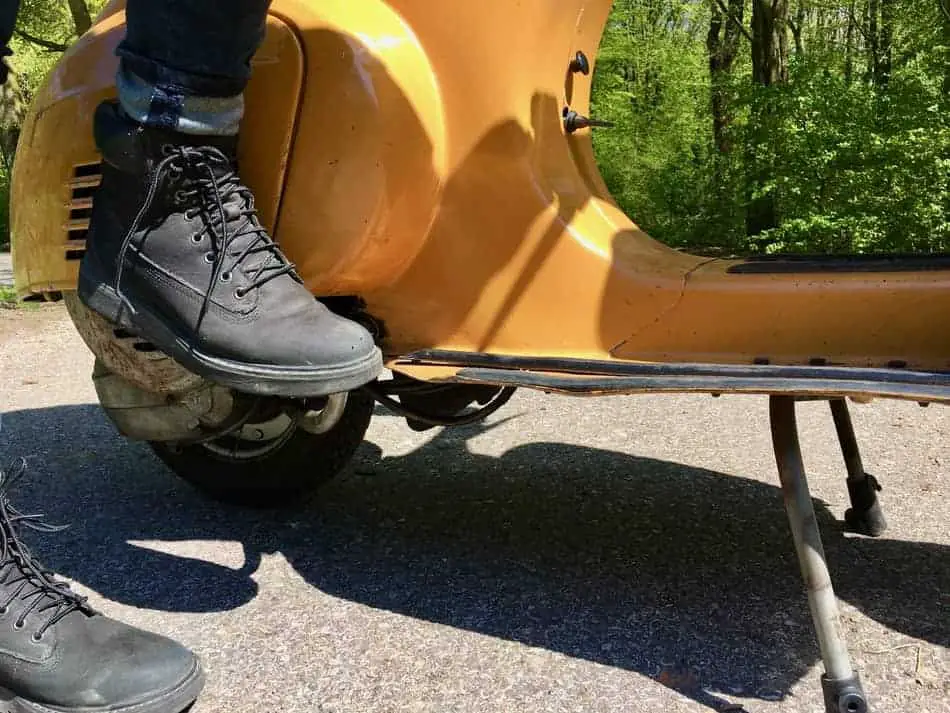
How to drive off on a classic Vespa
Then turn the gear to the 1st gear. Once the gear is in place don’t let go of the clutch yet! If so you will shoot forward and the engine will die immediately.
Once you are ready to go, slowly let go of the clutch. The Vespa will move as soon as you let go a bit. So just use your feeling on how gradually you should loosen the clutch. Every classic Vespa is different.
Driving a manual Vespa is like driving a manual car. Try to keep this in mind, so you will understand the concept of changing gears quicker.
You are off!
The engine will soon be ‘screaming’, hoping you will change gears soon. Change straight to the 2nd gear. Make sure you skip neutral. If you do happen to put it in neutral, don’t worry. The engine will still run but will not speed up because it will go straight to idle speed.
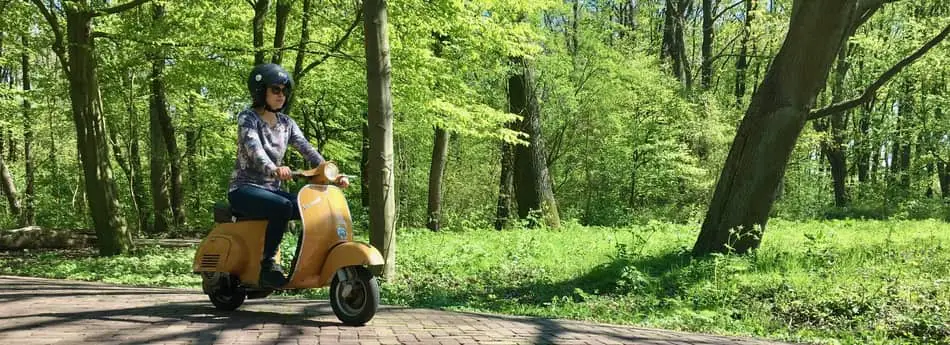
So now you are in the second gear. Drive a bit for the engine to warm up and for you to get comfortable. You might want to close the choke now.
You will soon notice that the RPM (rotations per minute) of the engine increases. This is the time to change it to the next gear. Listen carefully to the engine. The sound should be smooth and pretty nice to hear.
Congratulations, you have successfully had your first ride on a Classic Vespa.
A classic Vespa is not made for racing, so handle it with love and care when driving.
5. Change gears and practice taking a turn
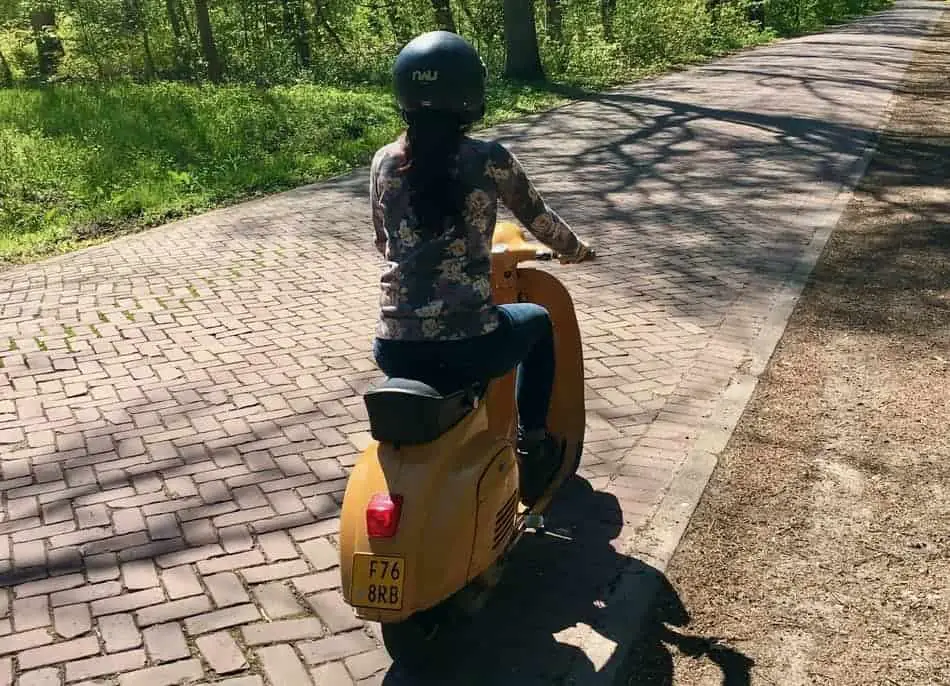
You are on the road and need to take a turn now. Like driving a manual car, you need to put the Vespa back in 2nd gear. So before you approach the corner, decrease your speed, pull in the left lever and turn the clutch forward into the 2nd gear.
Like an automatic Vespa, do not break or accelerate at the turn. Once you are out of the turn accelerate and turn the clutch back to the 3rd and/or 4th gear.
6. Return the gear to neutral and stop the engine
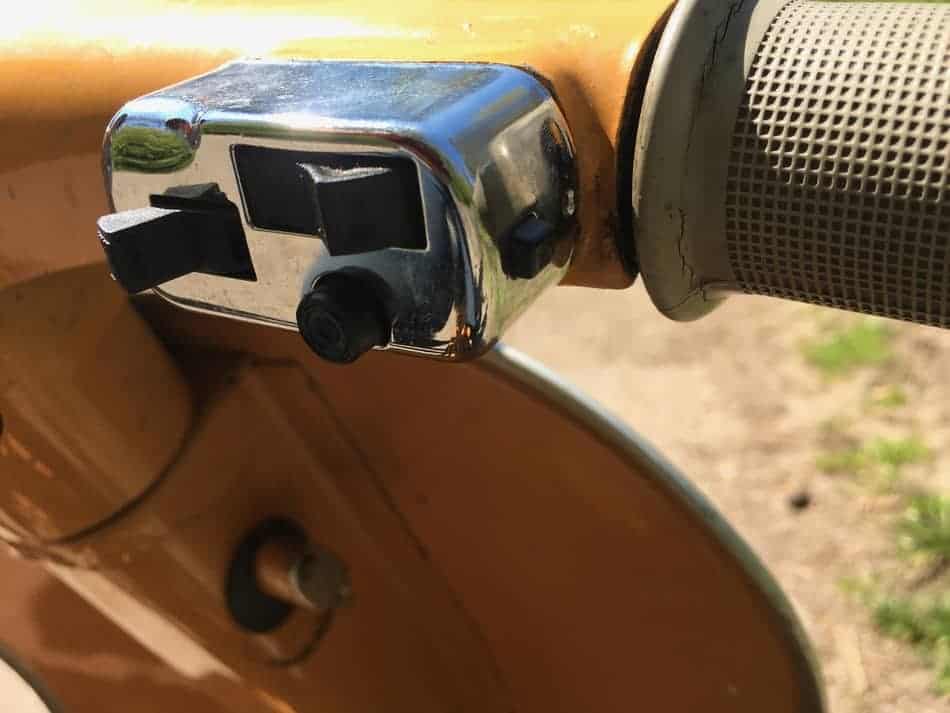
If you need to stop at a junction or a traffic light, you should slow down and at the same time decide if you want to stop in neutral or in the 1st gear.
- Neutral: your engine will idle and you can let go of the lever and the clutch. This is a good moment to stretch the fingers. You will now realize how tense they have been when driving.
- 1st gear: don’t let go of the lever. If you do so, the Vespa will jump forward a little bit and stall. You will then need to put it back in neutral and use the kickstart to get the engine running again.
How to fully stop the engine
Since the Vespa doesn’t have a key to start the ignition, you can stop the Vespa fully by pressing the kill switch. This switch is located on the right. Make sure you have the Vespa in neutral when you do this.
You can also do it the rough way: if you let it run in the 1st gear and you stop and let go of the clutch and throttle, the Vespa will jump forward a little and stop. Then while pushing the Vespa back and forth with your feet, turn the gear back to neutral to enable you to push the Vespa to its parking space.
I hope this article has guided you on your first (classic) Vespa ride. As I mentioned, safety is the first priority. So make sure you familiarise yourself first. Find a nice spot to practice without being distracted by other traffic.
Just one final warning though….once you ride a Vespa for the first time, there is a chance you will never want anything else 😉
More articles to read
Is Vespa Good For Beginners? Vespa vs Motorcycle
How To Park A Vespa Properly? 6 tips to safely park your scooter
What Vespa Should I Buy? Tips On Deciding Which Vespa Fits Your Needs
